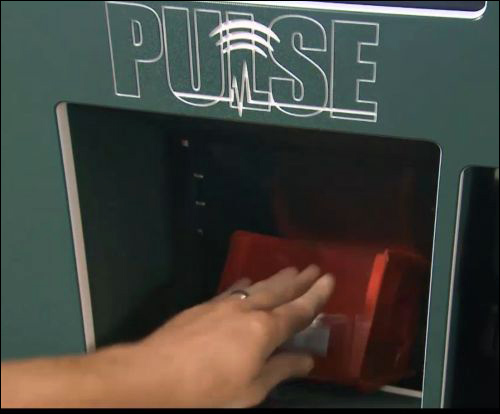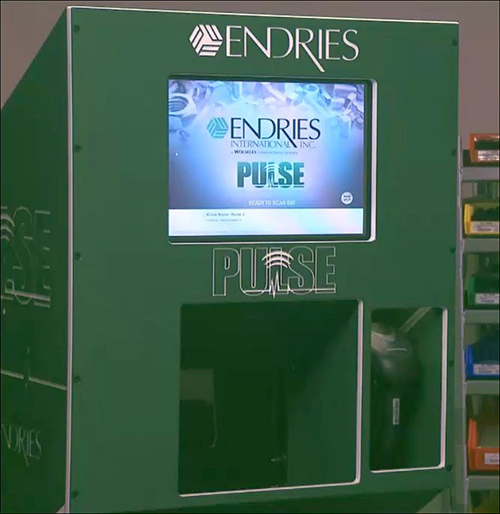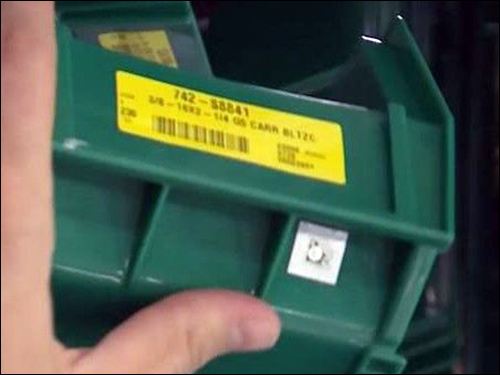Endries International, a distributor of fasteners and related production supplies, is offering its customers an RFID-driven service that automatically replenishes parts inventory. The service is designed to help its customers prevent out-of-stocks, speed up replenishment times and reduce the amount of inventory they need to keep on hand.
Endries, based in Brillion, Wisc., distributes fasteners and related production supplies to original equipment manufacturers (OEMs) throughout North America, Europe and Asia. The products that the company distributes are critical to the production of many types of equipment. In addition, Endries typically supplies a high number of stock-keeping units (SKUs) to each customer, thereby increasing the complexity of the process for monitoring those items’ inventory levels.
Endries has been providing the OEM marketplace with managed-inventory solutions since the mid-1980s. One common solution for Endries and other distributors of fasteners and related components, according to the company, has been to send a supplier’s representative to a customer’s facility to scan bins whenever the quantity of parts stored within those bins drops to a predetermined level, and to then create an order. Such a representative must be onsite at the customer’s facility, however, in order to process any reorders. Many times, it is not cost-effective for a customer to have the representative onsite on a daily basis, or even multiple times per week. Additionally, any time that the representative is not at the customer’s site, the supplier lacks visibility into that customer’s demand.
“We were looking for something different,” says Todd Fischer, Endries International’s VP and CIO. His firm had already been offering a multi-bin inventory-replenishment service—which, he says, could be described as a kanban system. With the multi-bin offering, Fischer explains, an OEM worker scans a bar-code label on an empty parts bin to trigger the reordering of the part.
A bar-code-based system is dependent on users physically scanning every bar code. “Our customers wanted their employees manufacturing their products, not scanning bins,” Fischer explains. Systems with scales for weighing each bin offer data regarding the exact quantity of parts inside a particular bin, but are expensive and often lack the flexibility to be moved around in what is typically a dynamic manufacturing environment.
Endries had investigated radio frequency identification as early as 2001, but had found, at that time, that the technology had both cost and reliability issues. When revisiting RFID in 2014, the company discovered that costs had come down and reliability had improved. What’s more, since the system would be operating at a customer’s site, but would be managed and used by Endries, the company needed it to be something that could be set up quickly and maintained remotely.
Endries worked with researchers and students at the University of Wisconsin-Madison’s RFID Lab to develop a solution. The group tested passive high-frequency (HF) 13.56 MHz RFID tags, compliant with the ISO 15693 standard, as well as ultrahigh-frequency (UHF) RFID tags, by reading them via handheld readers. In the long run, however, the technology would need to be installed in a portal. “The solution required a portal or chute to accept bins,” Fischer says.

Students helped to identify the best orientation of tags on the bins, and also led a project seeking solution providers based on Endries’ requirements. However, Fischer reports, they found no companies offering both hardware and software that would serve Endries’ needs. “Some did hardware, some did software,” he says.
There were specific challenges for the solution as well, Fischer adds, such as a high quantity of metal in racks and in the fasteners themselves. This led to a lot of false positive reads (nearby tags being read when they were not moving through the chute of the RFID-enabled used-bin container).
Endries, working with the university team, created a custom loop antenna and fitted each bin with two Smartrac Mini Block passive HF RFID tags, each encoded with a unique ID number, thereby bringing the read rate up to 100 percent. The ID encoded to each bin’s tags is linked in the system’s software to the specific type and size of the parts stored within that bin, as well to the customer’s account information. The system also includes a kiosk with a built-in Feig Electronics MR102 HF reader module and Endries’ own antenna, featuring Endries’ patent-pending design.
The company uses a customized version of S3edge‘s Spotlight web-based software to manage the kiosks. The software, residing on an Endries-hosted server, captures and stores data about each tag read.
The resulting RFID-based system, known as PULSE, works like this: When a worker empties a bin of Endries-supplied product, he or she drops it down a chute in the PULSE kiosk. A reader antenna in the chute captures the ID number encoded to one of the bin’s RFID tags. The kiosk displays the refurbishment order on its video screen and forwards the data to Endries’ server, where the Spotlight software captures the information and determines which bin at that customer’s site requires replenishment. Within one minute, Fischer says, from virtually anywhere in the world and at any time, Endries can thus capture the customer’s order.

The replenishment parts are then pulled at Endries’ warehouse and delivered to the customer’s site, where an Endries representative restocks the proper bin. He or she can use a mobile phone to access the consumption and replenishment data that the PULSE system provides. The process for the customer is simple: toss the empty bin down the kiosk’s chute, and Endries handles the rest.
Endries first tested the kiosk at a few customer sites in March 2015, and now offers the system to all customers and prospects. “The feedback on PULSE that we are getting from the market is outstanding—something so simple in concept being such a game-changer for the OEM customer,” Fischer says.


